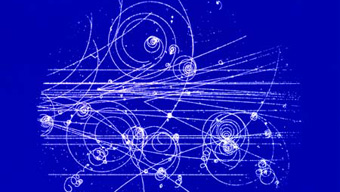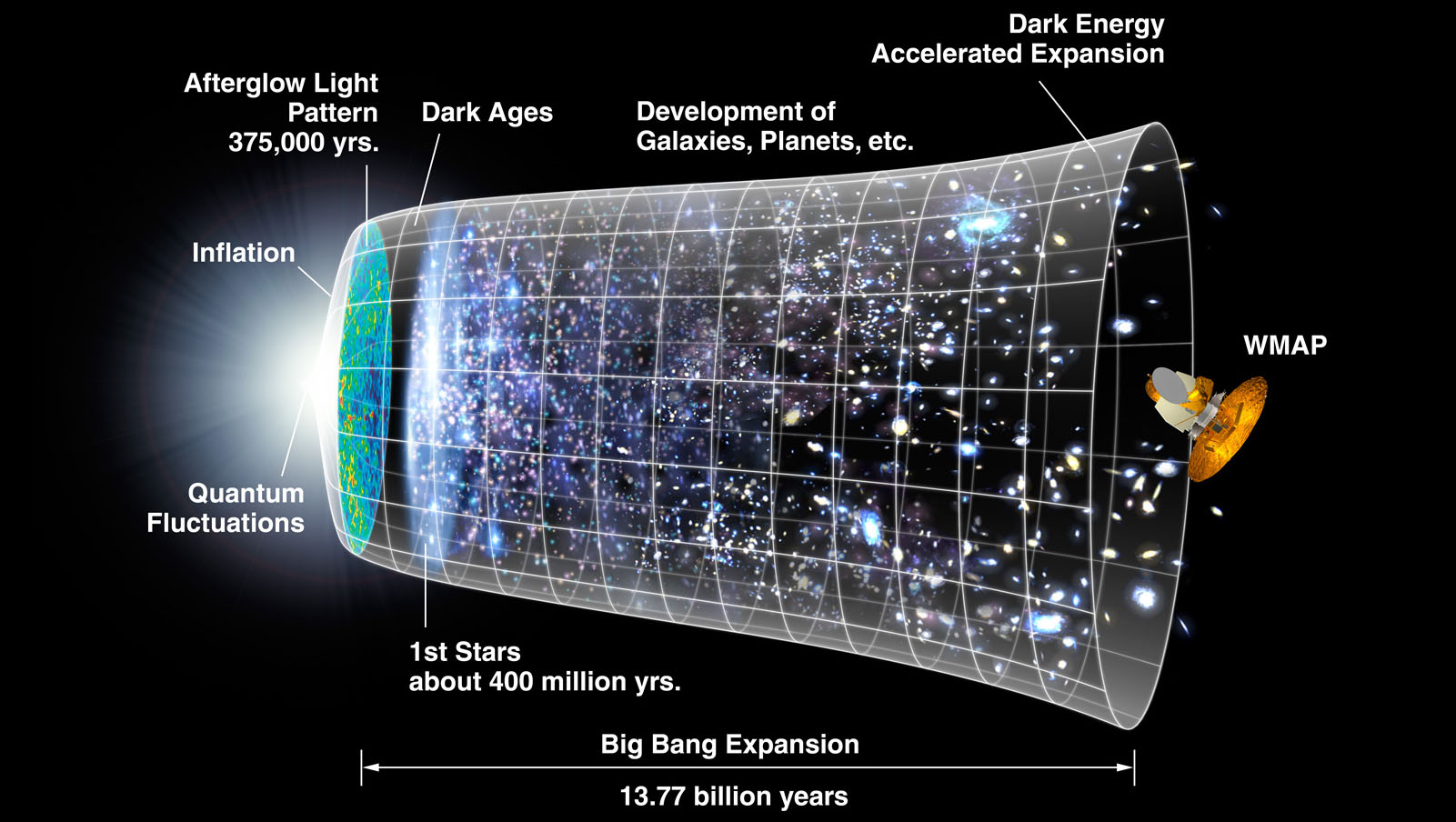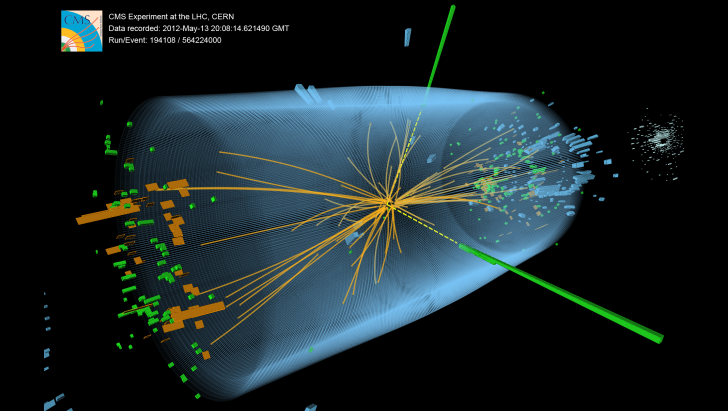Elementarteilchenphysik
 Wechselwirkung eines Teilchenstrahls aus Pionen (von links) in einer mit Wasserstoff gefüllten Blasenkammer. Bild: CERN Wir wissen heute, dass alle Materie in unserer Welt aus Objekten aufgebaut ist, die so klein sind, dass wir sie uns als punktförmig vorstellen. Wir nennen sie Quarks und Leptonen. Für ihre Ausdehnung gibt es bisher nur eine experimentell ermittelte obere Grenze von 10E-18 m. Insgesamt kennen wir sechs Quarks, sechs Anti-Quarks sowie sechs Leptonen und sechs Anti-Leptonen. Diese fundamentalen Bausteine sind in drei Familien angeordnet, und wir haben überzeugende Argumente dafür, dass dieser Satz von Familien vollständig ist. Die Kräfte zwischen diesen elementaren Teilchen werden auf vier fundamentale Wechselwirkungen zurückgeführt: die Gravitation, die elektromagnetische, die schwache und die starke Wechselwirkung. Wir stellen uns dabei vor, dass die Kräfte durch den Austausch von Teilchen, sogenannte Austausch-Bosonen, vermittelt werden. Dies sind die Gravitonen, die Photonen, die W- und Z- Bosonen und die Gluonen.
Wechselwirkung eines Teilchenstrahls aus Pionen (von links) in einer mit Wasserstoff gefüllten Blasenkammer. Bild: CERN Wir wissen heute, dass alle Materie in unserer Welt aus Objekten aufgebaut ist, die so klein sind, dass wir sie uns als punktförmig vorstellen. Wir nennen sie Quarks und Leptonen. Für ihre Ausdehnung gibt es bisher nur eine experimentell ermittelte obere Grenze von 10E-18 m. Insgesamt kennen wir sechs Quarks, sechs Anti-Quarks sowie sechs Leptonen und sechs Anti-Leptonen. Diese fundamentalen Bausteine sind in drei Familien angeordnet, und wir haben überzeugende Argumente dafür, dass dieser Satz von Familien vollständig ist. Die Kräfte zwischen diesen elementaren Teilchen werden auf vier fundamentale Wechselwirkungen zurückgeführt: die Gravitation, die elektromagnetische, die schwache und die starke Wechselwirkung. Wir stellen uns dabei vor, dass die Kräfte durch den Austausch von Teilchen, sogenannte Austausch-Bosonen, vermittelt werden. Dies sind die Gravitonen, die Photonen, die W- und Z- Bosonen und die Gluonen.
 Zeitleiste des Universums. Bild: NASA / WMAP Science Team Wir nehmen an, dass die Zahl der Teilchen und der entsprechenden Anti-Teilchen, die als Folge des Urknalls erzeugt worden sind, gleich groß war, und dass die meisten Teilchen/Anti-Teilchen Paare sich selbst vernichtet haben. Eine sehr kleine Asymmetrie, oder eine spontane Symmetriebrechung muss es jedoch gegeben haben. Daraus resultierte ein kleiner Überschuss von Materie im Universum, in dem wir heute leben.
Zeitleiste des Universums. Bild: NASA / WMAP Science Team Wir nehmen an, dass die Zahl der Teilchen und der entsprechenden Anti-Teilchen, die als Folge des Urknalls erzeugt worden sind, gleich groß war, und dass die meisten Teilchen/Anti-Teilchen Paare sich selbst vernichtet haben. Eine sehr kleine Asymmetrie, oder eine spontane Symmetriebrechung muss es jedoch gegeben haben. Daraus resultierte ein kleiner Überschuss von Materie im Universum, in dem wir heute leben.
Moderne theoretische und experimentelle Arbeiten in der Teilchenphysik haben es ermöglicht, die elektromagnetische, die schwache und die starke Wechselwirkung in einem einheitlichen Schema zu vereinen, dem Standardmodell. Es beschreibt eine große Zahl experimentell ermittelter Eigenschaften der Elementarteilchen und einfacher zusammengesetzter Systeme dieser Elementarteilchen. Einige Fragen bleiben jedoch ungeklärt. Insbesondere ist nicht klar, wie die Masse der Teilchen entsteht. Die favorisierte Lösung ist der "Higgs-Mechanismus". Aus diesem Grunde wurden große experimentelle Anstrengungen unternommen, das Higgs-Boson zu identifizieren und seine Masse zu ermitteln. Zur Zeit werden die Eigenschaften dieses Teilchens untersucht.
 CMS Higgs, Diphoton Event. Bild: CERN Das Standardmodell der Teilchenphysik hat noch mehr Parameter, deren Größe im Rahmen des Modells nicht vorhergesagt werden kann, und die daher empirisch eingeführt werden müssen. Dies zeigt, zusammen mit einer Reihe theoretischer Argumente, dass das Standardmodell erweitert werden muss. Man sucht daher nach physikalischen Phänomenen, die über den Rahmen des Standardmodells hinausgehen. Präzisionsmessungen an Atomen oder Neutronen suchen nach Abweichungen von den Voraussagen des Standardmodells.
CMS Higgs, Diphoton Event. Bild: CERN Das Standardmodell der Teilchenphysik hat noch mehr Parameter, deren Größe im Rahmen des Modells nicht vorhergesagt werden kann, und die daher empirisch eingeführt werden müssen. Dies zeigt, zusammen mit einer Reihe theoretischer Argumente, dass das Standardmodell erweitert werden muss. Man sucht daher nach physikalischen Phänomenen, die über den Rahmen des Standardmodells hinausgehen. Präzisionsmessungen an Atomen oder Neutronen suchen nach Abweichungen von den Voraussagen des Standardmodells.
Arbeitsgruppen: Beneke - Brambilla - Buras - Fierlinger - Garbrecht - Ibarra - Märkisch - Paul - Straub - Tancredi - Weiler